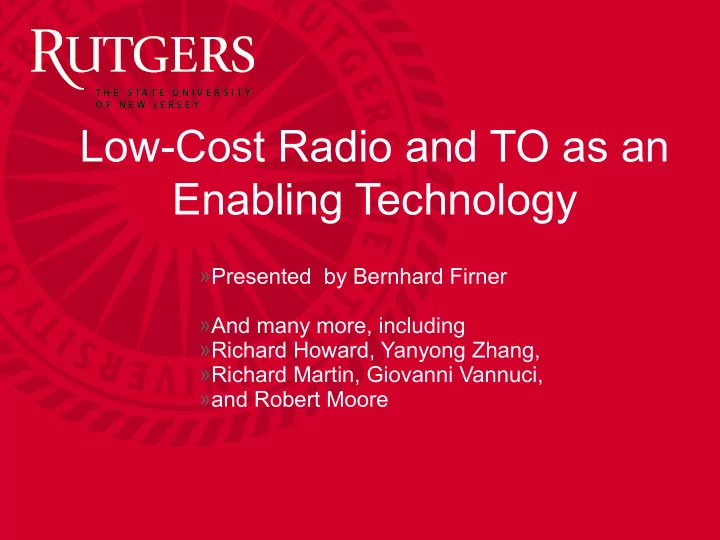

Low-Cost Radio and TO as an Enabling Technology »Presented by Bernhard Firner »And many more, including »Richard Howard, Yanyong Zhang, »Richard Martin, Giovanni Vannuci, »and Robert Moore
Simplification and Enabling Technologies The evolution of computing systems is a story of miniaturization and cost reduction Computers Per Person Bell's Law: “Roughly every 1:10 6 decade a new, lower Mainframe priced computer class Mini forms based upon a new 1:10 3 Workstation programming platform, PC Laptop network, and interface” 1:1 PDA (Wikipedia) Cell Tag 10 3 :1 years
The Vision of Tiny Computers Healthcare Environmental Monitoring Tracking and Logistics
This Vision Is Old News • 1999 Smart Dust • 2000 Sensor Networks • 2004 Internet of Things • 2005 Ambient Intelligence • 2009 Swarms So what is holding us back?
Wireless Sensors Are Small Enough Integrated circuits have followed Moore's law So what is missing? TelosB (2004) TO-PIP(2013) Antenna Radio Micro controller Battery
Some Insights • After deploying our own systems we encountered a few problems – Sensors are too expensive for application domains – Deployment and Maintenance – No general purpose solutions – Each application is unique – New software effort with each deployment – Infrastructure brittle, difficult to re-use
The Biggest Show-Stopper Is Cost • Sensor node cost is a limitation for many applications – Applications enabled at sensor cost of $100, $10, $1, 10¢, 1¢ ? • Cost assumptions based on scaling Moore's law real omit real constraints – Cost is driven by the number and type of components, not Moore's law! • Cost of maintenance is driven by sensor lifetime – But batteries aren't getting any smaller! • We need a simpler sensor, which means a simpler MAC 7
Transmit Only Approach • Key insight: sensed data is in a class where small losses can be tolerated. Probabilistic reception is OK. – Similar to audio, video, and multi-player games, not documents. • Sensors only sense and transmit with specified periods – Sensors are at most 1 hop – Add small amount of randomization to prevent collision periodicity. • A small set of receivers cooperate to reconstruct sensed data – Connected by a powerful back-haul network – Back-haul bandwidth > sensor bandwidth 8
TO - Less Is Better • Everything that doesn't transmit an application bit is overhead • Removed: – Sensing the channel before transmission (for CSMA protocols ) – Acknowledgements (for RTS/CTS protocols ) – Precise clocks and synchronization ( for TDMA protocols ) – Signal feedback ( MIMO physical layers ) 9
Transmit Only as Less Is Better • Focus on getting the sensed data: – Everything else is overhead • Saves energy on the sensor – Receiving has similar energy costs per bit-time as transmit • Simplify the sensors – Fewer components – Cheaper components – Smaller sensors Enabled a 10 year wireless sensor! 10
TO Enables New Kinds of Deployments • Sensors connect to an intermediate layer that hides details • Solvers build higher-level representations from low-level ones • A uniform model of the world allows sharing • Applications run in standard environments in the cloud
A Success Story • Ongoing Deployment in Rutgers Laboratory Animal Services – 24/7 monitoring of environmental conditions – temperature, light level, human activity – Real-time alerts when conditions go out of acceptable bounds – Long-term data logging – Reduces operating cost and improves quality of service 12
13
Conclusions ● Needed to reduce sensor cost Holding back envisioned wireless sensor deployments ● ● Found a way to simplify the sensor TO protocol increases lifetime while reducing complexity ● More cost-efficient to overcome problems in software of in receivers ● ● This has allowed us to create a real-world-ready system Deployment is fast ● Data is managed through a cloud platform ● Can offer deployments with positive value propositions ● 14
Recommend
More recommend